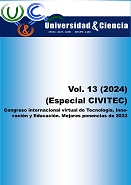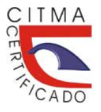Thermal evaluation of a conical solar oven in a warm climate
DOI:
https://doi.org/10.5281/zenodo.11588545Keywords:
food, oven, solar energy, temperaturesAbstract
Nowadays, the search for energy systems for cooking food has become very important in the face of high pollution from polluting sources such as firewood, gas and others that throw large amounts of carbon dioxide into the atmosphere and that have been associated with the climate change that we currently face. This work presents the results obtained from evaluating a Tolokatsin-type solar oven, with the purpose of taking advantage of solar energy as an alternative and non-polluting source for cooking food. An oven was monitored, to which adjustments were made to give it translational and rotating movement, in order to be able to direct it to obtain the best and greatest radiation from the sun. The temperatures were obtained at four points using sensors connected to Dataloggers, downloading the information into the HOBOware version 3.7.26 program for processing, and thus obtaining the temperature data. With the data obtained, it was determined that the time where the highest temperatures occurred was from 2:00 p.m. to 4:00 p.m., being highest between the range of 2:00 p.m. to 3:00 p.m. In addition, food was cooked practically to check the effectiveness of the oven. It can be concluded that this type of oven allows you to cook food and is a viable and economical alternative to replace other types of conventional ovens.
Downloads
References
Castell, María Emilia de, Finck Pastrana, Adolfo, Collares Pereira, Manuel, Fonseca Fonseca, Susana y Esteves Miramont, Alfredo (1999). Protocolo de cocción solar de RICSA. Apreciaciones respecto de la determinación de la energía y la carga para determinar la potencia efectiva de cocción. Avances en energías Renovables y Medio Ambiente (AVERMA). Argentina, ASADES, 4, 77-80. https://sedici.unlp.edu.ar/handle/10915/79080
Cocina Solar (s/f). Horno Solar – Funcionamiento, temperaturas, tiempos de cocción. https://gastronomiasolar.com/horno-solar-funcionamiento-temperatura/
Cocina Solar (s/f). Horno solar casero. https://gastronomiasolar.com/construir-horno-solar-casero/
Correa Marinez, Jorge Manuel (2012). Evaluación térmica de cocinas solares tipo caja y transferencia de tecnología en el Cantón Zapotillo Parroquia Bolaspamba Barrio Chaquino. Ecuador. [Tesis para obtener el Título de Ingeniero Electromecánico. Universidad Nacional de Loja. Ecuador]. 18 - 23.
Esteves A., Buenanueva, J. F., Cavagnaro, L. G. y Miralles, P. (2006). Horno solar con ganancia superior e inferior. Evaluación del rendimiento térmico. Avances en Energías Renovables y Medio Ambiente, 10, 77-82. Centro Regional de Investigaciones Científicas y Tecnológicas (CRICYT). Mendoza. Argentina.
Fernández Muerza A. (2014). Horno solar, cocinar con la energía del sol, EROSKI Consumer, España. https://www.consumer.es/medio-ambiente/horno-solar-cocinar-con-la-energia-del-sol.html
Montesinos González S., Hernández Echeverría Y., Santiago Alvarado A. y Miranda Márquez Mario (2016). Diseño de una estufa solar de geometría paraboidal portátil. Revista de la Ingeniería Industrial, 10(1), 30-36.
Ortiz Guzmán M., Alavéz Ramírez R. y Morales Domínguez Valentín J. (2014). Comportamiento de temperaturas en una estufa solar. Congreso Internacional Virtual de Innovación, Tecnología y Educación 2014. 9 al 11 de octubre. Tijuana, Baja California, México.
Ortiz Pérez W. (2023). Memoria de estadía profesional. Centro Interdisciplinario de Investigación para el Desarrollo Integral Regional (CIIDIR) IPN unidad Oaxaca. México.
Rio Portilla, J.A. del, Tapia Salinas, S. y Jaramillo Salgado, O. A. (2010). Cocedores Solares. Revista Digital Universitaria. 11(10), UNAM. México. http://www.revista.unam.mx/vol.11/num10/art93/index.html
Terres Peña H., Rodriguez Rivera R., Chavez Sánchez S., Lizardi Ramos A. y Carvajal Mariscal I. (2022). Determinación de las propiedades termofísicas de papa, zanahoria y calabacín durante su proceso de cocción en una estufa solar tipo caja. Congreso Internacional de Investigación Academia Journals. Puebla, 14 (6), 939-943.
Downloads
Published
How to Cite
Issue
Section
License
Copyright (c) 2024 Universidad & ciencia

This work is licensed under a Creative Commons Attribution-NonCommercial-ShareAlike 4.0 International License.





















